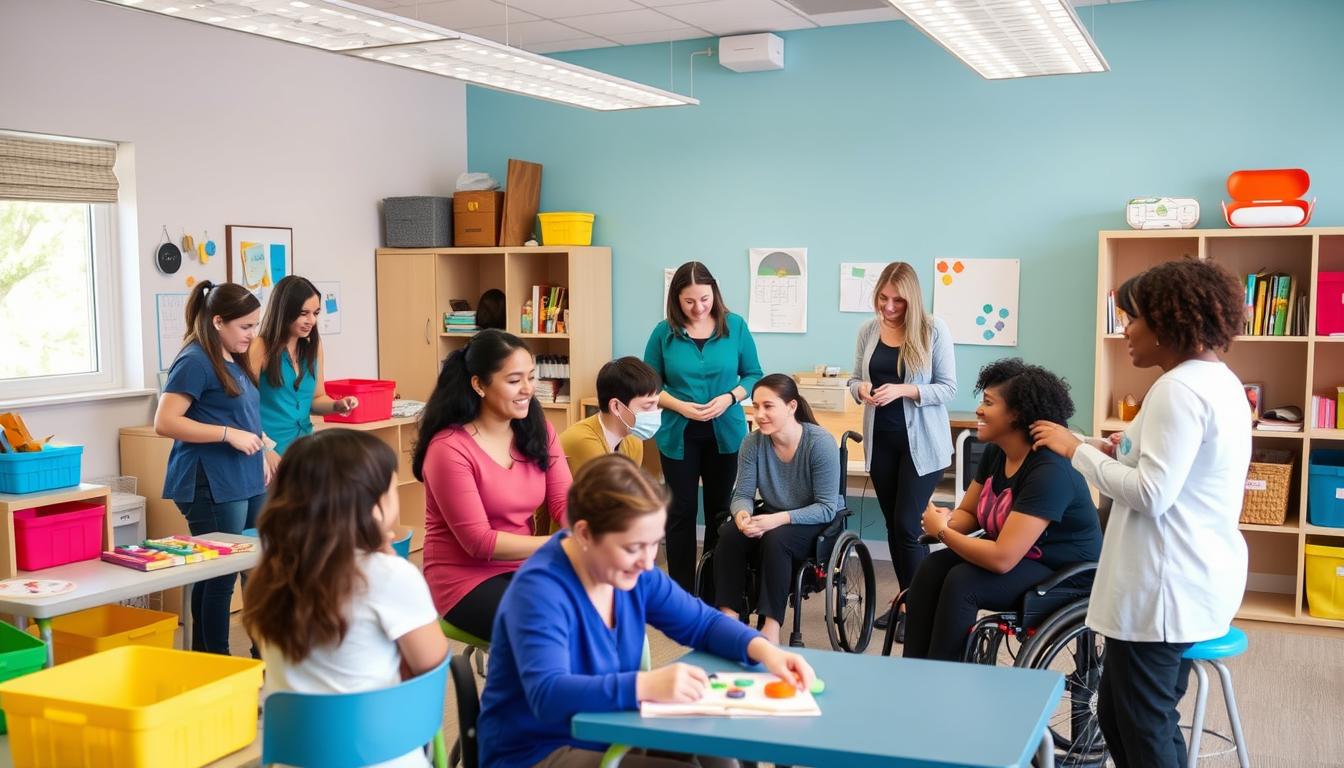Imagine a world where people with physical, cognitive, or sensory challenges can be independent and do well daily. This is what occupational therapy (OT) does, changing lives for millions. At Keka Rehab Services, OT experts help people in many areas, from babies to seniors. They use detailed rehab plans to help patients get better, return to work, and live independently.
OT is more than rehab. It helps people overcome obstacles and regain control of their daily lives. OT pros work on things like fine motor skills and essential self-care. They use a holistic approach to meet each person’s needs, improving their lives.

Occupational therapy is a special kind of treatment. It helps people do daily tasks safely and independently. The main aim is to make people as independent as possible. This is done by focusing on their physical, mental, and social needs with custom-made plans. It helps people of all ages, from kids to seniors, in different places.
Kids might need particular occupational therapy designed just for them. It’s also for people recovering from injuries, dealing with ongoing conditions, or having disabilities. The goal is to help them do things on their own again. Therapy might include learning to use tools, exercising, and getting mental health support.
Occupational therapists check on people, make plans just for them, and track their progress. OT helps people of all ages with physical, sensory, or cognitive issues become more independent. It boosts kids’ fine motor skills, eye-hand coordination, and basic life skills.
Occupational therapy can help kids and teens with various issues like birth injuries, sensory problems, and learning challenges. Therapists tackle emotional, social, and physical hurdles. They use everyday activities and therapies to help.
Occupational therapy helps people with many challenges. It’s for those with developmental disabilities, recovering from injuries, or dealing with mental health issues. Occupational therapists help people of all ages become independent and fully participate in daily life.
Occupational therapy is beneficial for kids and teens with autism, sensory issues, learning problems, or cerebral palsy. Therapists create special plans for these children and help them improve their daily skills and quality of life.
Occupational therapy is vital to improving the health of adults with physical problems. It helps those recovering from injuries, dealing with chronic illnesses, or managing arthritis or joint replacements. Occupational therapists work with patients to get them back to doing things independently.
Occupational therapy also helps with mental health and behavioural issues. It tackles the practical and emotional hurdles that make daily tasks difficult, allowing people to manage their conditions better and be part of their communities.
No matter the challenge, occupational therapy offers a tailored, whole approach. It helps people of all ages face challenges and find their purpose and happiness again.
Occupational therapy (OT) and physical therapy (PT) both aim to improve individuals’ lives. OT helps with fine motor skills, visual-perceptual abilities, cognitive skills, and sensory-processing problems, allowing people to do the activities they find meaningful. Physical therapy focuses on pain, strength, and movement to improve physical function and mobility.
The Bureau of Labor Statistics says physical therapy will grow by 28% by 2026, faster than average. Occupational therapy is expected to grow by 24% during the same time, faster than average. Physical therapists help people move better, reduce pain, and improve their ability to do daily tasks. Occupational therapists make daily activities more manageable.
Occupational therapy is expected to grow by 12% from 2022 to 2032, and physical therapy by 15%. In 2023, occupational therapists made a median salary of $96,370, and physical therapists made $99,710.
In summary, OTs and PTs work with patients of all ages in different places and have various ways of treating them. PTs focus on rehab and preventing injuries, while OTs help people get back to daily tasks after injuries or developmental delays.
Occupational Therapists (OTs) and Occupational Therapist Assistants (OTAs) provide occupational therapy services. These professionals work together to help people of all ages and abilities perform daily tasks and live independently.
Occupational therapists work in many places, showing their flexibility. They have a four-year bachelor’s degree and a master’s in occupational therapy from an approved program. They check patients, make treatment plans, and give therapy to meet their clients’ needs and goals.
OTAs work as a team and help with therapy plans under an occupational therapist’s watchful eye. They have an associate’s degree from an approved program and can help with occupational therapy tasks. OTAs work with OTs to give clients care that helps them live better and independently.
OTs and OTAs must do fieldwork and pass exams to work in most states. This rigorous training and certification ensures that they can provide top-notch occupational therapy.

Occupational therapy focuses on helping people with daily tasks and improving their environments, with care tailored to each person. Working with others, like families and volunteers, is critical to occupational therapy success, demonstrating the importance of teamwork.
Occupational therapists work in many places to help people of all ages reach their goals. They work with patients, families, and other healthcare workers to create plans that make daily life easier. These plans help with physical, mental, and social skills.
Occupational therapists often work in hospitals, rehab centres, mental health facilities, schools, and private offices. The Bureau of Labor Statistics says there will be more job openings for occupational therapists soon. This is because more people need therapy as the baby boom generation ages, and more people have disabilities.
Occupational therapists can focus on different areas, such as working with older adults, mental health, or helping kids. They can also help people drive, make their homes safer, or eat better. This means they can help people of all ages, from babies to seniors.
Once certified, occupational therapists must keep learning new things every year. This keeps them up-to-date with the latest in their field. Occupational therapy is a fulfilling job for those who want to help people live better lives every day.
If you or a loved one needs occupational therapy, there are ways to find a qualified OT. Start by asking your primary care doctor for a referral to an occupational therapist. You can also talk to your child’s school nurse or guidance counsellor for a recommendation based on the student’s needs.
Another option is to contact a nearby hospital, rehabilitation centre, or children’s clinic. These often have OTs on staff or can refer you.
You can also check your state’s Occupational Therapy Association’s website to find licensed OTs in your area. This is a great way to find an OT, as these associations have detailed directories of their members and expertise.
When looking at potential OTs, ask about their certification, training in Sensory Processing Disorder, experience with children with developmental issues, and the tools they use. In some places, finding OTs with specialized training might be tricky. Families might need to look for therapists with less specialized training or travel for intensive treatment.
Occupational therapy (OT) helps people with physical, sensory, or cognitive issues. It aims to make daily tasks easier. OT uses activities and exercises to improve emotional, social, and physical abilities.
Many people can benefit from OT, including those with developmental disabilities, physical injuries, and mental health issues. It also helps children and adults do daily tasks better and live independently.
OT and PT both aim to improve quality of life but in different ways. PT focuses on pain, strength, and movement skills, while OT works on fine motor skills, cognitive abilities, and sensory issues.
OTs and OTAs provide OT services. OTs have a bachelor’s or master’s degree in OT, while OTAs have an associate’s degree and work under OT supervision.
OTs work in various places to help people with daily tasks. They are found in hospitals, rehab centres, schools, and private practices.
To find an OT, ask your doctor for a referral. Contact schools, hospitals, or your state’s OT association. They can help you find licensed OTs near you.